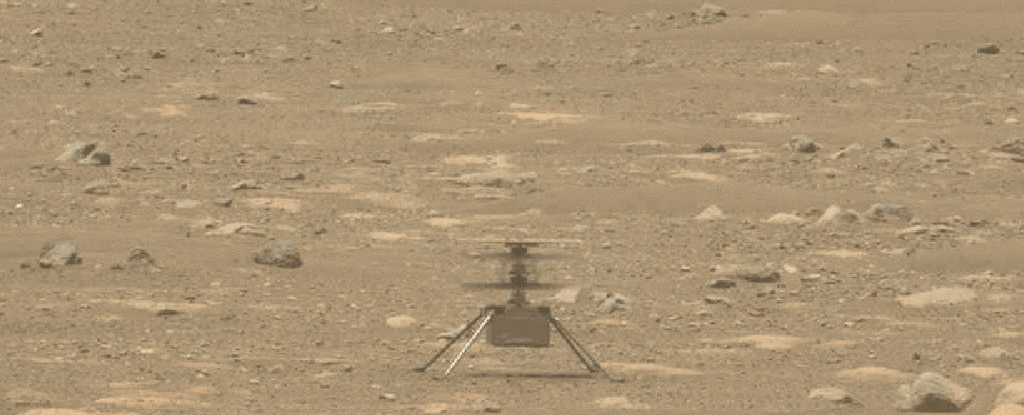
It only had to be flown five times. However, NASA’s helicopter on Mars, Ingenuity, has completed 12 flights and is not ready to take off.
Given its unexpected and unexpected success, the US space agency has expanded the mission of Ingenious indefinitely.
The small helicopter has become the usual travel companion of the Perseverance rover, whose main mission is to look for signs of ancient life on Mars.
“Everything works so well,” said Josh Ravich, the head of Ingenuity’s mechanical engineering team. “On the surface we do better than we expected.”
Hundreds of people contributed to the project, although currently only a dozen retain daily functions.
Ravich joined the team five years ago.
“When I had the opportunity to come and work on the helicopter project, I think I had the same reaction as anyone else: ‘Is it even possible?'”
His initial doubts were understandable: Mars’ air has a density equivalent to only one percent of the Earth’s atmosphere. By comparison, flying a helicopter to Mars would be like flying one at a distance of almost 30 kilometers from Earth.
Nor was it easy to get to Mars in the first place. The craft had to withstand the initial shock of Earth’s takeoff and then the Feb. 18 landing on the red planet after a seven-month journey through space, tied to the rover’s belly. .
Once in its new environment, the small helicopter (four pounds or 1.8 kilograms) has had to survive the icy cold of the Martian nights, drawing heat from the solar panels that charge its batteries during the day. And its flights are guided by a series of sensors, as the 15-minute delay in communications from Earth makes real-time guidance impossible.
Scouting duties
On April 19, Ingenuity made its first flight, making history the first motorized ship to fly to another planet.
Exceeding all expectations, it has flown 11 times more.
“We were actually able to withstand winds higher than we had expected,” Ravich told AFP.
“I think on flight three we had achieved all of our engineering goals … (and) we got all the information we hoped to get,” said Ravich, who works for NASA’s famous Jet Propulsion Laboratory (JPL). who developed the helicopter.
Since then, the aircraft has flown up to 12 meters and its last flight lasted two minutes and 49 seconds. In all, he has covered a distance of 1.6 miles.
In May, Ingenuity made its first one-way mission, landing off the relatively flat “airfield” that had been carefully selected as its initial home.
But not everything has gone well. His sixth flight caused some excitement.
After being dangerously unbalanced by a malfunction affecting the photos taken in flight to help it stabilize, the small boat was able to recover. He landed, safe and sound, and the problem was solved.
Just keep flying 🚁#MarsHelicopter completed his 6th flight. Despite the unexpected movement of an image processing problem, the craft experienced the last ~ 65 meters of the 215-meter course, landed safely and is ready to fly again. The chief pilot explains https://t.co/533hn7qixk pic.twitter.com/IHkkjXaHDd
– NASA JPL (@NASAJPL) May 27, 2021
He now sends wit to explore the path to perseverance, using his high-resolution color camera.
The purpose is twofold: to chart a safe path for the rover, but also of scientific interest, especially in geological terms.
Ken Farley, who heads the Perseverance science team, explained how photos taken by Ingenuity during its 12th flight showed that a region dubbed South Seitha had less interest than scientists had expected.
As a result, the rover may not be shipped.
Favorable conditions
After more than six months on the red planet, the small drone-like vessel has gained increasing traction on Earth, appearing in coffee cups and t-shirts sold on the Internet.
What explains its longevity?
“The environment has been very cooperative so far: temperatures, wind, sun, air dust … It’s still very cold, but it could have been a lot worse,” Ravich said.
In theory, the helicopter should be able to continue operating for a while. But the approaching Martian winter will be a challenge.
NASA engineers, now armed with data from Ingenuity flights, are already working on their next-generation successors.
“Something between 20 and 30 kilograms (range) could perhaps carry scientific payloads,” Ravich said.
These future payloads could only include rock samples collected by Perseverance.
NASA plans to retrieve these samples during a future mission, sometime in the 2030s.
© France-Presse Agency